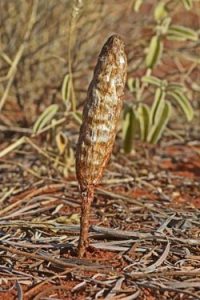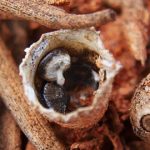 Fungi are present throughout most of the organic material in the environment – such as wood, soil, dung and carcases – and play important roles in the ecology of natural ecosystems. Through the processes of decay they are recyclers of organic material, releasing nutrients back into the soil. Symbiotic relationships between fungi and the roots of plants ensure the survival of both. They are critical food sources for many native mammals, reptiles and invertebrates.
Fungi are present throughout most of the organic material in the environment – such as wood, soil, dung and carcases – and play important roles in the ecology of natural ecosystems. Through the processes of decay they are recyclers of organic material, releasing nutrients back into the soil. Symbiotic relationships between fungi and the roots of plants ensure the survival of both. They are critical food sources for many native mammals, reptiles and invertebrates.
Living organisms on Earth can be assigned to one of five kingdoms – the Monera (bacteria and blue-green algae), plants, animals, fungi and the Protists.
Unlike green plants, fungi lack chlorophyll for photosynthesis, so must absorb their energy and nutrients from the substrates in which they grow. The relationship between fungi and their substrates varies with species. Saprotrophic fungi gain their energy by breaking down the lignin, cellulose or chitin of dead organic material. They play a vital role in reducing the accumulation of dead organic material and in the recycling of essential nutrients, particularly carbon and nitrogen. Some fungi are parasites, obtaining their nutrients from living organisms with no benefit to the respective host and, in some cases, killing it.
 Other fungi have a mutually-beneficial symbiotic relationship with a living organism. Mycorrhizal fungi have a special relationship with the rootlets of trees and other plants. In return for having their energy needs met, the hyphae of these species greatly increase the volume of soil from which the plant can take up water, nutrients and trace elements. Such fungi are essential for the healthy growth of native forests in Australia’s impoverished soils.
Other fungi have a mutually-beneficial symbiotic relationship with a living organism. Mycorrhizal fungi have a special relationship with the rootlets of trees and other plants. In return for having their energy needs met, the hyphae of these species greatly increase the volume of soil from which the plant can take up water, nutrients and trace elements. Such fungi are essential for the healthy growth of native forests in Australia’s impoverished soils.
Fungi comprise microscopic filaments (hyphae) which form a web-like mass (mycelium) ramifying throughout the substrate. The mycelium is the actual fungus – its vegetative structure – and, while individual hyphae are rarely seen, the mycelial mass can sometimes be seen in the substrate, such as that of Trametes coccinea in wood (see below).

Fungi usually reproduce by spores – minute reproductive cells, up to 10 microns in diameter – which are dispersed by air, water, animals and sometimes the fungus itself. Under certain environmental conditions the mycelium produces reproductive structures (fruit-bodies) from which the spores are dispersed. The fruit-bodies take a wide range of forms according to the particular species and many of the macrofungi (in which the fruit-bodies are large enough to be seen with the unaided eye) are identified by their fruit-bodies.
 For the purposes of description, fungi can be placed into morphological groups – an artificial grouping of similar-shaped fruit-bodies. These include puffballs, earthstars, bird’s nests, polypores, crusts, brackets, boletes and the familiar agarics (like mushrooms). While the majority of the fungi found in the arid areas explored by Desert Discovery are tough and dry, facilitating their discovery, some that erupt after the occasional fall of rain are ephemeral making their opportunistic discovery of great value to science.
For the purposes of description, fungi can be placed into morphological groups – an artificial grouping of similar-shaped fruit-bodies. These include puffballs, earthstars, bird’s nests, polypores, crusts, brackets, boletes and the familiar agarics (like mushrooms). While the majority of the fungi found in the arid areas explored by Desert Discovery are tough and dry, facilitating their discovery, some that erupt after the occasional fall of rain are ephemeral making their opportunistic discovery of great value to science.
The fifth kingdom of living organisms, the Protists, include the Myxomycota (slime moulds). Slime moulds share some of the characteristics of both fungi and amoebae. Their immature cells combine in a slime-like mass called a plasmodium that moves amoebae-like over moist substrates and consumes bacteria, fungi and decaying organic matter. When food supplies are exhausted, or in response to changing environmental conditions, a chemical signal causes the cells to coalesce and form the fruiting body, called a sporangium, in which the spores are produced. The plasmodium stage depends on moisture and is extremely ephemeral in arid regions but their sporangia or spores can be collected from a range of substrates and grown in the laboratory for identification. Such was the case with a new species – Clastoderma confusum (it’s sporangium is depicted below) – collected during the 2018 Desert Discovery project.

